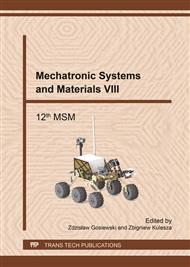[1]
J. Adamovski, C. Gambaro, E Lertora, M. Ponte, M. Szkodo. Analysis of FSW welds made of aluminium alloy AW6082-T6. Archives of Materials Science and Engineering, vol. 28, issue 8 (2007) 453-460.
Google Scholar
[2]
S. Missori, A. Sili, Mechanical behavior of 6082-T6 aluminium alloy welds. J. Metallurgical Science and Technology, vol. 18, No 1 (2000) 12-18.
Google Scholar
[3]
T. Luijendijk. Welding of dissimilar aluminium alloys. J. of Materials Processing Technology, vol. 103 (2000) 29-35.
DOI: 10.1016/s0924-0136(00)00415-5
Google Scholar
[4]
P. Kah, M. Olabode, E. Hiltunen, J. Martikainen. Welding of a 7025 Al-alloy by a pulsed MIG welding process. J. Mechanika, vol. 19, No 1 (2013) 96-103.
DOI: 10.5755/j01.mech.19.1.3618
Google Scholar
[5]
M. Ericsson, R. Sandstrom. Influence of welding speed on the fatigue of friction welds, and comparison with MIG and TIG. International Journal of Fatigue, vol. 25 (2003) 1379-1387.
DOI: 10.1016/s0142-1123(03)00059-8
Google Scholar
[6]
H.J. Park, D.C. Kim, M.J. Kang, S. Rhee. Optimisation of the wire feed rate during pulse MIG welding of Al sheets. J. of Achievements in Materials and Manufacturing Engineering, vol. 27, issue 1 (2008) 83-86.
Google Scholar
[7]
M. Tiryakioglu, J.S. Robinson, M.A. Salazar-Guapuriche, Y.Y. Zhao, P.D. Eason. Hardness-strength relationships in the aluminium alloy 7010. Materials Science & Engineering A, vol. 631 (2015) 196-200.
DOI: 10.1016/j.msea.2015.02.049
Google Scholar
[8]
M. Tiryakioglu, J. Campbell, J.T. Staley. On macrohardness testing of Al-7 wt. % Si-Mg alloys: II. An evaluation of models for hardness-yield strength relationships. Materials Science & Engineering A, vol. 361, issues 1-2 (2003) 240-248.
DOI: 10.1016/s0921-5093(03)00514-8
Google Scholar
[9]
P.A. Stathers, A.K. Hellier, R.P. Harrison, M.I. Ripley, J. Norrish. Hardness-tensile property relationships for HAZ in 6061-T651 aluminium. Welding Journal, vol. 93 (2014) 301-s - 311-s.
Google Scholar
[10]
A.K. Lakshminarayanan, V. Balasubramanian, K. Elangovan. Effect of welding processes on tensile properties of AA6061 aluminium alloy joints. Int. J. Adv. Manuf. Technol., vol. 40 (2009) 286-296.
DOI: 10.1007/s00170-007-1325-0
Google Scholar
[11]
H.R. Ghazvinloo, A. Honarbakhsh-Raouf, N. Shadfar. Effect of arc voltage, welding current and welding speed on fatigue life, impact energy and bead penetration of AA6061 joints produced by robotic MIG welding. Indian J. of Science and Technology, vol. 3, issue 2 (2010).
DOI: 10.17485/ijst/2010/v3i2.8
Google Scholar
[12]
B. Gungor, E. Kaluc, E. Taban, A. Sik. Mechanical, fatigue and microstructural properties of friction stir welded 5083-H111 and 6082-T651 aluminium alloys. J. Materials and Design, vol. 56 (2014) 84-90.
DOI: 10.1016/j.matdes.2013.10.090
Google Scholar
[13]
R. Gitter. Design of aluminium structures: selection of structural alloys. Eurocodes – Background and Applications, Brussels (2008) 32 p.
Google Scholar
[14]
BS EN ISO 9692-3: 2001. Welding and allied processes – Recommendations for joint preparation. Part 3: Metal inert gas welding and tungsten inert gas welding of aluminium and its alloys. British Standard Institution, London (2001) 20 p.
DOI: 10.3403/02283396u
Google Scholar
[15]
EN ISO 4136. Destructive tests on welds in metallic materials. Transverse tensile test. European Committee for Standartization, Brussels (2012) 22 p.
Google Scholar
[16]
Y. Hirata. Pulsed arc welding. Welding International, vol. 17, No 2 (2003) 98-115.
DOI: 10.1533/wint.2003.3075
Google Scholar


